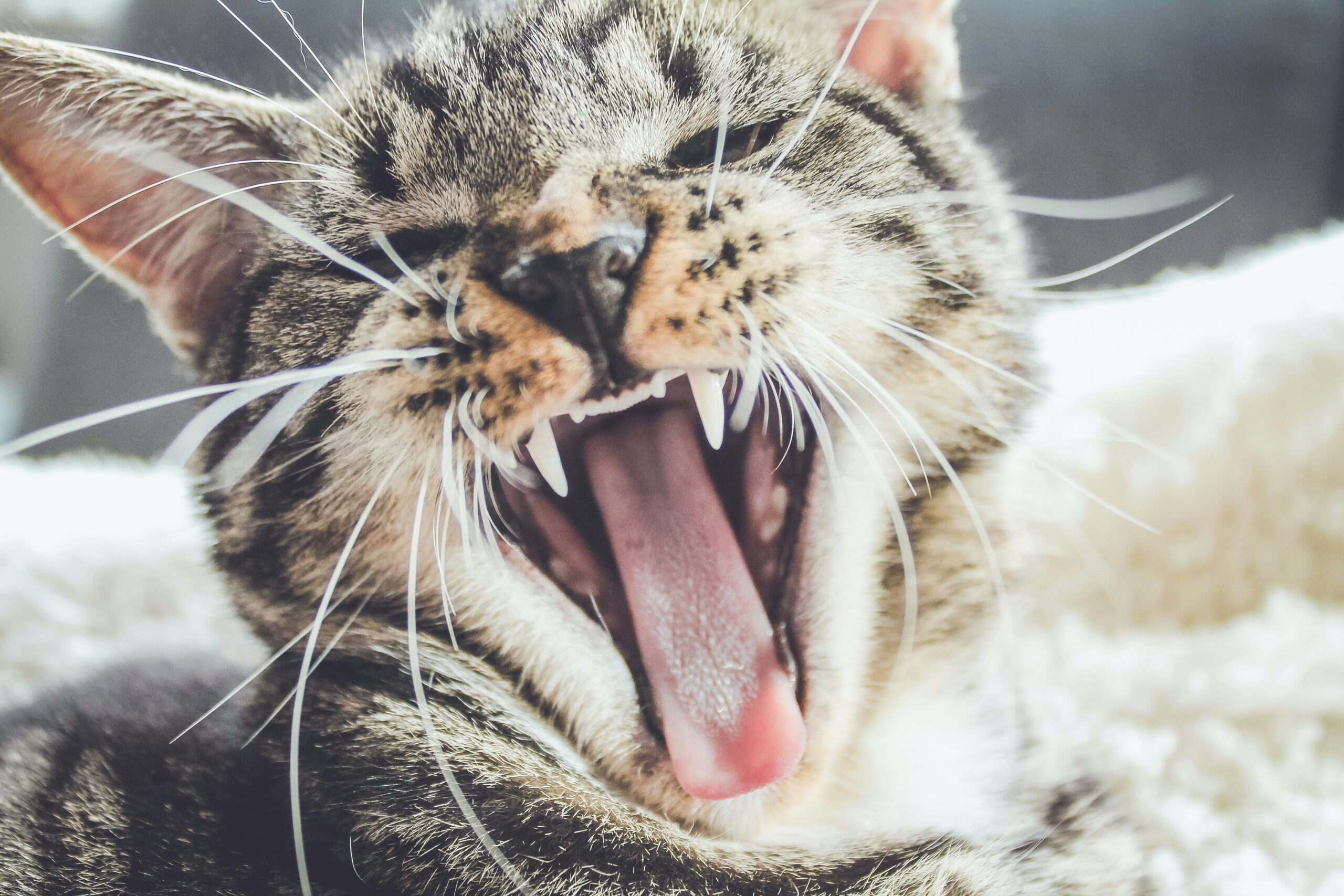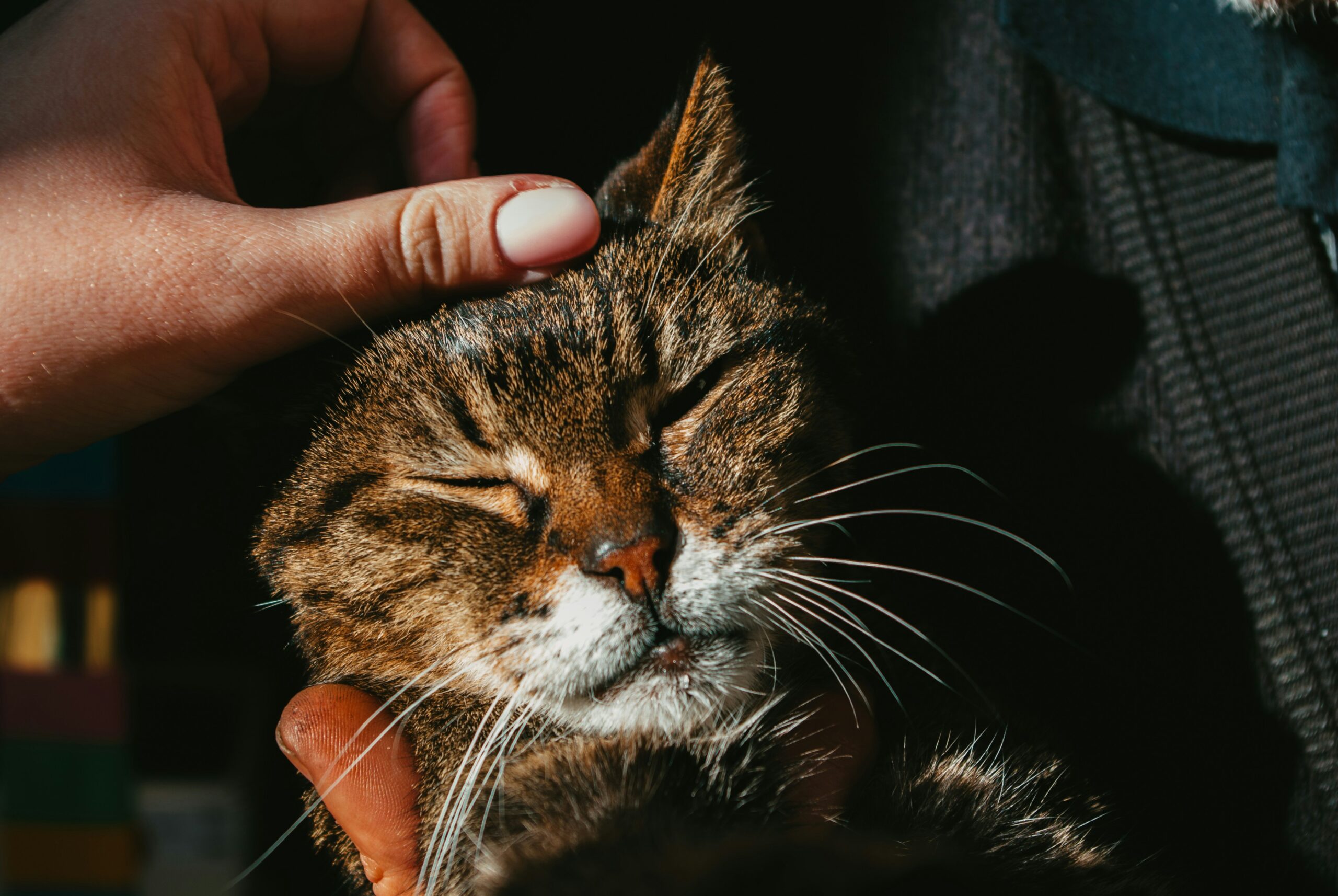You lean in for a head-bump…and whoa. If your cat has bad breath, you’re not alone. Many cat parents think it’s just “a cat thing,” but persistent odor—what veterinarians call halitosis—is usually a warning sign that something in your cat’s mouth (or even their body) needs attention. Addressing the source of cat bad breath is crucial for long-term health, preventing pain and protecting vital organs. The good news? Most cases of cat bad breath are treatable with simple daily habits and the right veterinary care. In this guide, we’ll explore what’s normal, what’s not, and the smart steps you can take today to help your cat feel healthier—and smell fresher.
What Actually Causes Cat Bad Breath (Halitosis) in Cats?
Think of breath as a status update from your cat’s mouth and body. When it smells off, there’s usually a reason.
1) Dental Disease: The #1 Cause of Cat Bad Breath
In most cases, cat bad breath = dental trouble. After meals, a sticky film called plaque coats the teeth. Minerals turn that into tartar (calculus), which irritates the gums and invites gingivitis. If it digs under the gumline, you get periodontal disease—painful inflammation, infection, and bone loss that really smells.
What you’ll notice
- Sour or rotten odor that’s always there
- Red, puffy, or bleeding gums
- Brown tartar, creamy/yellow plaque
- Drooling, pawing at the mouth, chewing on one side
- Weight loss, skipping dry food, less grooming
Other dental culprits: tooth resorption (FORLs), cracked teeth, ulcers, and stomatitis (an intense, immune‑driven inflammation that makes the whole mouth painful).
2) Diet and Eating Habits That Contribute to Bad Breath in Cats
Sticky wet foods and soft treats can cling to teeth and decompose—fuel for odor. Scavenging human scraps or eating too fast may trigger reflux or Gupset that you can smell. Diets full of fillers or artificial additives can also nudge the oral microbiome out of balance.
For healthier choices, review our guide: What Can I Feed My Cat? Safe and Healthy Options Explained.
3) Medical Conditions: When Cat Has Bad Breath Linked to Illness
Bad breath in cats isn’t always about teeth. Pay attention to these “scent clues”:
- Kidney disease (uremia): breath that’s ammonia/urine‑like or metallic, plus thirst, frequent urination, weight loss, low energy.
- Diabetes mellitus: sweet or fruity/acetone smell, increased drinking and urination; sometimes weight loss despite a hearty appetite.
- Liver disease: foul odor with lethargy, vomiting, or yellow gums/eyes.
- GI infections or blockages: rotting or fecal odor.
- Oral cancer: bleeding or ulcerated masses that smell bad.
- Stomatitis: extremely bad breath with drooling and food refusal.
Not all halitosis is dental. Fruity/acetone breath may signal diabetes; ammonia/metallic breath can point to kidney disease. Compare symptoms with our primer: Feline Kidney Disease Stage Symptoms and Care Tips. For a medical overview, see Cornell Feline Health Center.
4) Foreign Objects in the Mouth Causing Cat Bad Breath
Strings, plant awns, bone shards, even tiny toy parts can get wedged between teeth or under the tongue. They fester, ulcerate, and stink quickly.
5) Breed Factors
Flat‑faced cats (Persian, Exotic) sometimes sleep with mouths slightly open, so mild morning odor can happen. Some breeds (Persian, Siamese, Burmese, Maine Coon) are simply more prone to dental disease and need closer monitoring.
How to Figure Out What’s Causing Cat Bad Breath
If your cat has bad breath, start with a quick home check and then loop in your vet for a definitive answer.
gns to Watch for at Home if Cat Has Bad Breath
- Drooling, pawing at the mouth, face rubbing
- Eating on one side, dropping kibble, yowling while eating
- Red, swollen, or bleeding gums; broken or missing teeth
- Changes in grooming (messier coat), facial swelling
- Odor “decoder”: fruity = possible diabetes, ammonia/metallic = kidneys, rotten/fecal = GI disease or severe oral infection
Pro tip: Note when the smell is worst (mornings, after wet food, or constant), what your cat eats, and any behavior changes. This timeline helps your vet land on a diagnosis faster.
For day‑to‑day wellness and monitoring tips, see Daily Cat Care Routine for Beginners.
Why a Vet Exam Matters
A veterinarian can see what you can’t: below the gumline. Many cats need sedation or anesthesia for a complete oral exam, dental radiographs, and proper cleaning. Blood/urine tests help rule in or out kidney, liver, or diabetic causes. This is the fastest route to fixing cat bad breath for good.
Effective Solutions for Cat Bad Breath
Once you know the “why,” the “how to fix it” gets easy.
At-Home Dental Care Tips to Fix Cat Bad Breath
- Brush, if you can. It’s the gold standard. Aim for daily, or at least 3–4 times a week. Use a cat‑sized soft brush or finger brush; angle bristles at the gumline.
- Cat toothpaste only. Choose an enzymatic, cat‑safe paste (poultry/fish flavors are popular). Never use human toothpaste (xylitol/fluoride can be dangerous).
- Go slow and reward. Start with gentle touches, then brief strokes, then full brushings. Praise and tiny treats help older cats learn.
- If brushing is a battle:
- Dental wipes/gels (chlorhexidine or enzyme‑based)
- VOHC‑approved chews/diets (look for the Veterinary Oral Health Council seal)
- Water additives (use in one bowl; offer a second bowl of plain water)
- Chew toys & puzzle feeders to stimulate saliva and light abrasion
Curious about supplements? Some owners try colostrum or microbiome‑supporting products. Evidence in cats is still emerging—ask your vet before adding anything.
Untreated dental disease is the leading cause of cat bad breath. According to the American Veterinary Medical Association, dental plaque and tartar can lead to gingivitis, periodontal disease, and systemic infection.
Professional Dental Cleaning for Bad Breath in Cats
If there’s gingivitis, tartar, or suspected periodontal disease, your vet may recommend an anesthetized dental prophylaxis: scale above/below the gumline, polish to slow future plaque, and take dental X‑rays to spot hidden lesions. Treating disease early prevents pain and tooth loss—and dramatically improves cat bad breath. Severe stomatitis may call for medical therapy or strategic extractions to restore comfort.
Smarter Food Choices That Prevent Cat Bad Breath
- Pick high‑quality, easily digestible formulas with minimal fillers.
- Consider VOHC‑accepted dental diets (kibble designed to reduce tartar).
- If wet food makes odor worse, pair meals with a dental kibble or a chew to “finish” the mouth.
- Raw feeding can scrape teeth but has pathogen risks—only consider with veterinary guidance and strict food‑safety practices.
- Probiotics formulated for pets may support a healthier oral and gut microbiome.
Wet foods and sticky treats may worsen odor. A guide from International Cat Care explains how diet affects your cat’s dental health and breath.
Treat the Root Cause
If tests point to kidneys, diabetes, liver issues, infections, or cancer, your vet will treat that problem first—insulin for diabetes, renal diets/fluids for kidney disease, pain control/antibiotics as needed, and so on. As the underlying condition improves, so does the breath.
Prevention: Keep That Breath Fresh for the Long Haul
Prevention is kinder to your cat—and your wallet.
Routine Vet Visits
Plan annual wellness exams (semi‑annual for seniors or high‑risk breeds). Early catches of gingivitis, tooth resorption, or metabolic disease are easier and cheaper to fix.
Make Oral Care a Habit
Even brushing three times a week plus VOHC chews or gels can stop the plaque‑tartar‑inflammation cycle that drives cat bad breath. Don’t forget the bowls—wash food and water dishes daily to break up biofilm.
Hydration Helps
Saliva is nature’s mouth rinse. Encourage drinking with a water fountain, extra water stations, or pet‑safe broths. Hydration supports the oral environment and discourages smelly bacterial overgrowth.
Smart Diet & Safer Habits
Limit sticky human foods and sugary treats. Offer safe chews and keep strings/bones out of reach to avoid lodged objects. Learn your cat’s “normal” neutral breath so you’ll catch changes early.
When Cat Has Bad Breath: Signs You Should Call the Vet
Mild morning funk after wet food? Not urgent. But severe or persistent cat bad breath—especially with the signs below—needs prompt care:
- Vomiting, lethargy, behavior change
- Weight loss (with or without big appetite)
- Heavy drooling, blood in saliva, or facial swelling
- Chewing on one side, dropping food, refusing meals
- Pawing at the face or mouth
- Fruity/sweet breath → diabetes concern
- Ammonia/urine‑like or metallic breath → kidney concern
- Rotten/fecal odor → GI disease or severe infection
- Bleeding gums, loose or missing teeth, thick tartar
- Big changes in thirst/urination
Early help = less pain, fewer complications, faster relief.
Final Thoughts: Stop Bad Breath in Cats and Keep Them Healthy
Cat bad breath isn’t a personality trait—it’s a signal. With simple at‑home habits, smart food choices, and routine veterinary care, you can protect your cat from painful dental disease and catch bigger issues early. Trust your nose, trust your gut, and partner with your vet. Fresher breath is a bonus; a healthier, happier cat is the real win.
Frequently Asked Questions (FAQ)
How do you get rid of cat halitosis?
Build a routine: brush several times a week with cat‑safe enzymatic toothpaste, add VOHC‑approved chews or dental diets, and use a gel or water additive if brushing is tough. If odor doesn’t improve within a couple of weeks—or returns quickly—book a vet exam to rule out dental disease or medical causes of bad breath in cats.
Why does my cat’s breath smell so bad?
Most often: plaque/tartar → gingivitis → periodontal disease. Other causes include sticky diets, GI problems, kidney disease (ammonia scent), diabetes (fruity/acetone scent), liver disease, oral cancer, lodged foreign bodies, or stomatitis. If your cat has bad breath plus other symptoms, call your vet.
What can I give my cat for bad breath?
VOHC‑approved treats and chews, dental wipes or chlorhexidine/enzymatic gels, and some water additives can help. They’re add‑ons—not replacements—for brushing and professional care when disease is present.
What should my cat’s breath smell like normally?
Pretty neutral. Not minty, but definitely not offensive. Fishy, rotten, fruity, or ammonia‑like odors are red flags worth a vet visit.
Does wet cat food cause bad breath?
Wet food doesn’t “cause” odor by itself, but it can cling to teeth and feed bacteria. If you notice worse cat bad breath on wet diets, pair meals with a dental kibble or chew and prioritize brushing.
Friendly reminder: This article is educational and not a substitute for a veterinary diagnosis. If something feels off—or smells off—your vet is your best partner.



